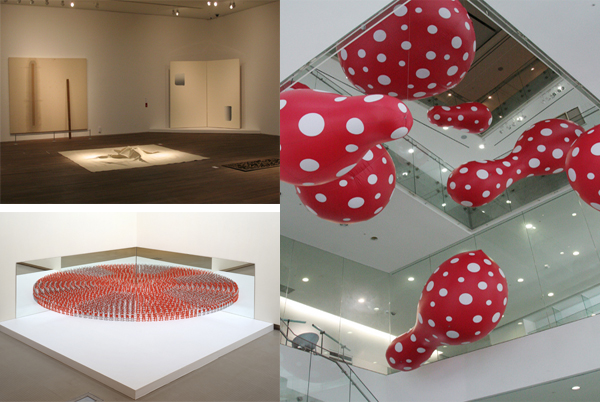Contemporary art challenges assumptions about Japan

Clockwise from left: “Banzai Corner”(1991) by Yukinori Yanagi, “Mono-ha” movement works and the sculpture “Dots Obsession” by Yayoi Kusama are part of the ongoing exhibition “Re: Quest - Japanese Contemporary Art Since the 1970s” at the Seoul National University Museum of Art in southwestern Seoul. Provided by the museum
They are works by Japanese artist Yayoi Kusama, famous for her obsession with dots, and part of the ongoing exhibition “Re: Quest - Japanese Contemporary Art Since the 1970s.”
The show, a collaboration between the Korean museum in southwestern Seoul and the Japan Foundation, allows viewers to explore Japanese art from the last four decades with about 120 works by 53 artists.
The exhibit includes pieces by international stars well-known to Koreans such as the sculpture series “Dots Obsession” by Kusama and the painting “Flower Smiles” by pop artist Takashi Murakami, inspired by Japanese manga.
There is also a series of paintings by Yoshitomo Nara that depicts children looking sullen or cross in his signature “cute-but-dark” style that has gained great popularity here.
But the more noteworthy part of the exhibition includes works by veteran artists who played important roles in Japanese contemporary art but are little known to the Korean public and those by up-and-coming young artists.
The artists range from Jiro Takamatsu (1936 -1998), who led the “Mono-ha” movement of the 1970s, to 38-year-old Koki Tanaka, who will represent the Japanese pavilion at the 2013 Venice Biennale starting in June.
One of the rooms for the exhibition is dedicated to artists of Mono-ha, which is translated as “School of Things.” It mainly holds sculptures and installations that incorporate basic materials such as rock, sand, wood and cotton, often simply arranged in blank space to bring out aesthetics unique to East Asia.
There is also a painting by the Japan-based Korean artist Lee Ufan.
“As Lee is such an important figure in Mono-ha, we have included him,” explained Tohru Matsumoto, deputy director of the National Museum of Modern Art, Tokyo.
He and three other Japanese and Korean curators, who collaborated on this exhibition, attended the press preview earlier this month along with several participating artists.
“The 1970s deeply reflected the modernist ideals of Universalism,” Matsumoto said. “Its vocabulary and methods were applied to explore psychological and social domains in the 1980s. The following decade saw young artists begin adopting a completely new perspective: they started viewing Japanese culture as if they were foreign.”
One example from the 1990s is “Banzai Corner”(1991) by 54-year-old Yukinori Yanagi, with cool and satirical tones about the vestiges of militarism in Japan.
This installation features many red figurines of Ultraman, who was once a popular superhero in Japan but is now nearly forgotten. They pose as if crying “Banzai,” a traditional Japanese salute to the monarch, and are arranged toward a corner so that their reflection in a mirror forms the Japanese flag.
“With its reiteration of inward-facing figures with raised arms, the work exudes the closed-off nature of militarism,” art critic Yoko Nose said in the exhibition book.
The exhibit also includes work from the 2000s. “From the 2000s, it came to a new generation of artists who sought to present the daily life of a highly diverse and complex society in films and installations,” Matsumoto said.
Tanaka is among such artists. His eight-channel video work “Everything Is Everything”(2006) shows a strange harmony of trivial sounds such as those made from the opening of an umbrella or the falling of a mop.
“I attach importance to the fact that everyday objects have sounds, and I use the objects to create sounds,” he said during the press preview.
“A exhibition introducing Japanese artwork since the 1970s in a comprehensive manner has never been held in Korea, and even in Japan, only a few exhibitions like this have been organized,” Matsumoto said.
The show runs through April 14. Admission is 3,000 won ($2.70) for adults. Hours are 10 a.m. to 6 p.m. every day except Monday. Go to Seoul National University Station, line No. 2, exit 3, and take the green bus No. 5511 or 5513. For details, call (02) 880-9504 or visit www.snumoa.org.
By Moon So-young [symoon@joongang.co.kr]










with the Korea JoongAng Daily
To write comments, please log in to one of the accounts.
Standards Board Policy (0/250자)